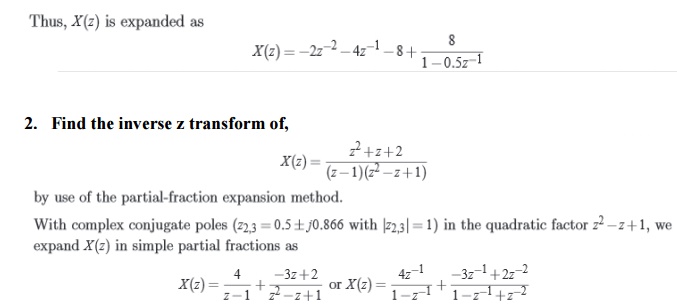Chapter: Signals and Systems : Analysis of Discrete Time Signals
Important Short Questions and Answers: Analysis of Discrete Time Signals
1. What is the relation between Z
transform and fourier transform of discrete time signal.
X(ω)=X(Z)|z=ejω.This means Z
transform is same as fourier transform when
evaluated on unit circle.
2. Define region of convergence
with respect to Z transform.
Region of convergence (ROC) is the area in Z
plane where Z transform convergence
.In other word, it is possible to calculate
the X(z) in ROC.
3. State the initial value theorem
of Z transforms.
The initial value of the sequence is given as,
X(0)=limz->1X(z).
4. What is meant by aliasing?
When the high frequency interferes with low
frequency and appears as low
then the phenomenon is called aliasing.
5. Define Nyquist rate and Nyquist
interval.
When
the sampling rate becomes exactly equal to ‘2W’ samples/sec,for a give
bandwidth of W hertz, then it is called Nyquist rate .’
Nyquist
interval is the time interval between any two adjacent samples.
Nyquist
rate =2W hz&Nyquist interval=1/2W seconds.
6. Define unilateral Z-Transform or
one sided Z-transform
The
unilateral Z-Transform of signal x(t) is given as,

The
unilateral and bilateral Z-Transforms are same for causal signals.
7. State the final value theorem
for z-transform.
The
final value of a sequence is given as,

8. Define DTFT pair.
DTFT,

9. State the sampling theorem.
•
A bandwidth signal of finite energy, which has no frequency components higher
than W hertz, is completely described by specifying the values of the signal at
instants of time separated by 1/2W seconds.
•
A band limited signal of finite energy, which has no frequency components
higher than W hertz, may be completely recovered from the knowledge of its
samples taken at the rate of 2W samples per second.
10. Define two sided Z transform.
The
z- transform of the DT signal is given by,

Here
‘z’ is the complex variable. The z- transform pair is denoted by,

11. State the convolution property
of z transform.
The
convolution states that,

That
is the convolution of two sequences in time domain is equivalent to
multiplication of their z-transforms.
12. State parseval‟s theorem.
Consider
the complex valued sequences x(n) and y(n).
If
x(n)----_X(k)
y(n)----_Y(k)
then
x(n)y*(n)=1/N X(k)Y*(k)
13. Find Z transform of
x(n)={1,2,3,4} x(n)= {1,2,3,4}
X(z)=
x(n)z-n
=
1+2z-1+3z-2+4z-3.
=
1+2/z+3/z2+4/z3.
14. What z transform of (n-m)?
By
time shifting property
Z[A
(n-m)]=AZ-m sinZ[ (n)] =1
15. Obtain the inverse z transform
of X(z)=1/z-a,|z|>|a|
Given
X(z)=z-1/1-az-1
By
time shifting property
X(n)=an.u(n-1)



Related Topics